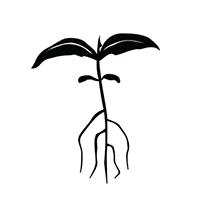Description
Botanical name : Ocimum basilicum
Synonyms :
Common name : Sweet Basil, Genovese Basil, Tulsi (India), Italian Basil, Purple Basil
- Easy/Intermediate
- Lifecycle: Annual
- Pollination: cross-pollinated by insects
- Mating system: short description, including flower type (perfect, monoecious, dioecious etc)
- Suggested spacing: Plant at the same or slightly larger spacing than for eating
- Seed specific requirements: None
- Isolation distance: 250 to 500 metres
- Population size: 20 plants
- Seed maturity: Flower bracts dry and brown on the stalk
- Processing method: Dry processing
- Expected seed viability: 5 years
Images

- Small image that represents the plant, flowers or fruits and seeds.
- Seed
- Seedling
- Plant at eating stage (if leafy green etc. not fruit)
- Plant at flowering
- Plant fruit
- Harvest time
Growing for seed
Grow it in the same way as for eating but only grow one type of basil with in a 250 to 500m radius as varieties can freely cross.
When growing for seed we want to encourage some lateral growth so we get plenty of flower heads on the plant, but this is balanced with not wanting to deplete the energy of the plant and hence the seeds. Pinch out early growth to encourage branching but do not continue to do this once some branching is established.
Plants will remain in the garden until the seed heads have matured on the plant so the extra time for that needs to be taken into account in any garden plans.
Selection
Remove plants that are more susceptible to pest or disease from the gene pool and also any that are not the required leaf type, flavour or colour.
Diseases & Pests (Optional section)
Basil is generally not significantly attacked by pests. It does occasionally suffer from fungal diseases which appear as black spots on the leaves.
Harvest
Basil’s flowering spike progressively produces flowers as it grows upwards. Those lower down the stalk will mature before those at the top.
The seed is mature when the flower bract holding the seed has gone brown. The trick is to harvest before the first matured seed is dropped into the garden and when as many of the flower bracts have dried off as possible. Basil generally holds on to its seeds in the bracts reasonably well. Seed may need to be harvested a bit early if significant rain is forecast.
Harvest by cutting either the whole plant or the flowering stems.
The stems can be put into a bag and hung up or spread on a tarp or sheet under cover while they dry. In either case they need to be placed in a dry location.
Processing
Basil seed is a small, oval shaped dark brown to black seed. Seed needs to be removed from the bracts. Some will fall out during the drying phase. Using a gloved hand to run along the stems is a fairly quick way to dislodge seed from small quantities of plant material. Larger quantities can be threshed by gently walking on the plant material or using a threshing machine.
Once the seed is broken out of the bracts it will need to be sieved and winnowed to remove all the unwanted pieces of plant material leaving just good seed.
After processing it is a good idea to keep the seed in a paper bag in a dry location for another few weeks to ensure that any moisture being held in the seed by the plant material has a chance to dry off.
There is a fair likelihood that insect pests will have laid their eggs in or on the seed. To stop them in their tracks one of the easiest methods of control is to freeze the seed for a few days. To do this the seed must be absolutely dry first. It then must be placed in an airtight container – like a glass jar. 48 to 72 hours in the freezer is all that is required to kill pests and their eggs.
Seed is best stored in an airtight container where it is dark, cool and dry.
Cultivation
- How is it grown?
- Sowing dates. Suitable climates. Germination temps etc?
History
- Any relevant historical info regarding origins, cultivation and other salient details.
Uses
- How is it used?
- How to eat or cook it?
Contributors: Liz Worth, Julie Davies
Other Resources
- Links to other sites and videos that are useful
